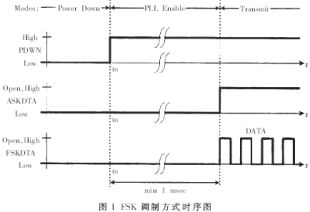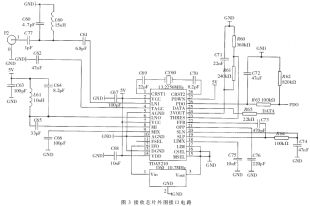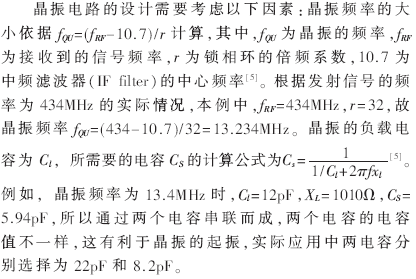At present, the tire pressure monitoring system TPMS (Tire Pressure Monitoring System) for automobile safety is gradually coming to the market and becoming a standard configuration in the automobile, which plays an irreplaceable role in protecting the safety of motorists and pedestrians.
This article refers to the address: http://
In the active TPMS, the monitored pressure, temperature and other data need to be transmitted to the console in real time. The pressure monitoring module is usually installed on the valve or mounted on the hub by means of a tight clamp. Therefore, the data monitored by the two installation methods can only be transmitted to the receiving device in the cab through wireless communication, so as to promptly remind the driver. Pay attention to changes in tire pressure to avoid possible accidents.
In the actual use of TPMS, it is impossible to disassemble the tire frequently to replace the battery for the transmitting module, so it is necessary to make the pressure monitoring module and the tire have the same life. This puts a very demanding requirement on the power consumption of the transmitting module. It requires both the largest possible transmission power and the timely and accurate transmission of the signal to the receiving end. It also requires that the energy required for transmission be as small as possible and less. Consuming the energy of the battery, correspondingly extending the life of the transmitter module. In this way, it is required to select a chip with high emission efficiency as much as possible in the actual design, and the fewer peripheral interface circuits are better, and the power consumption of the system is comprehensively reduced in various aspects.
Due to the harsh operating environment inside the tire, there are many difficulties in transmitting and receiving signals, which requires high parameters such as power consumption and temperature of the chip. At present, manufacturers that can provide such wireless transmitting and receiving chips on the market mainly include MAXIM, ATMEL, Infineon, and freescale. According to the actual needs of use, comprehensive consideration of factors such as power consumption and anti-interference in several types of products, this design Infineon's transmitter chip TDK5110 and receiver chip TDA5210 were selected, and the sensor chip selected Infineon's SP12.
1 transmitting chip circuit design
The operating frequency of the single-chip ASK/FSK transmitter chip TDK5110 is 433MHz to 435MHz, which is the ISM (Industrial Scientific Medical Band) band. The TDK5110 integrates a PLL and has a highly efficient power amplifier to drive the transmit antenna. The chip operates over a temperature range of -40 to 125 ° C and has a supply voltage range of 2.1 to 4 V [2], which fully satisfies the required temperature on automotive tires. voltage range.
The TDK5110 provides two data modulation methods, ASK and FSK. ASK is very susceptible to noise interference. FSK is superior to ASK in terms of anti-jamming, and the special operating environment in which the tire is located is subject to a lot of interference. Therefore, this design uses the data modulation method of FSK. The chip inside the TDK5110 mainly includes a transmit power amplifier (PA), a crystal oscillator (OSC), a voltage controlled oscillator (VCO), a phase detection (PD) circuit, a frequency divider, a loop filter (LF), an FSK switch, etc. [ 2]. The peripheral components of the chip are few, which is beneficial to the reduction of system cost, and also facilitates parameter setting and debugging of the system.

In this design, the center frequency of the transmitting chip is 434MHz, and an external crystal oscillator of 13.56MHz is used, and 434MHz is obtained by multiplying the phase-locked loop by 32 times. The choice of the transmitting antenna can be either a single-ended antenna or a PCB printed antenna. Since the weight of the entire transmitting module is limited in the tire, it is better to choose a PCB printed antenna. In order to obtain good performance, when designing the board, the area enclosed by the antenna ring should be as large as possible. The closer to the edge of the ring, the higher the density of the field, so the shape of the design is similar to a square [6].
The TDK5110 offers three power modes: Power Down Mode, PLL Enable Mode, and Transmit Mode [2]. In low-power mode, the entire chip stops working, and the typical value of current consumption is 14nA at 85°C. In PLL enable mode, the PLL starts to work and the power amplifier (PA) does not start. The startup time of the PLL mainly depends on The size of the external crystal is generally less than 1 millisecond, and the current consumption is 4 mA. In the transmit mode, all parts of the chip start to work, and the current consumption is typically 14 mA. Of course, in the actual use process, the chip is in a low-power mode most of the time, that is, during the driving process of the car, the data is also intermittently transmitted. Therefore, some transmission modes and frequency of transmitting data can be set by software in order to effectively reduce the power consumption of the system. This design uses the data modulation method of FSK, so according to the timing logic diagram of FSK modulation shown in Figure 1, the peripheral circuit connection of the whole chip is shown in Figure 2. Among them, CLKOUT is a clock signal synchronized with the microcontroller, FSKDATA is a signal connected to the TXD pin of the microcontroller, and the PDWN and ASKDATA pins are connected to the two I/O pins of the microcontroller, and the data transmission mode can be controlled by software. .

2 receiving chip circuit design
The receiving chip corresponding to the TDK5110 is the TDA5210. The TDA5210 is a low-power single-chip FSK/ASK superheterodyne receiver chip that operates in the ISM's 810MHz to 870MHz and 400MHz to 440MHz bands. The integration of the chip is high, and fewer peripherals are needed, which is beneficial to the user's design. The chip has a low noise amplifier (LNA), a double balanced mixer (mixer), a voltage controlled oscillator (VCO), a phase-locked loop (PLL), a crystal oscillator, a limiter, and a phase-locked loop FSK demodulation. Circuitry (PLL FSK demodulator), data filter, data slicer, peak detector, etc. [3].
The receiving end selects the FSK data modulation mode. At this time, the current consumption is 5.9 mA, the receiving sensitivity is -100 dBm, and the current consumption is 50 nA in the low power mode.
The receiving antenna selects a whip antenna with a length of λ/4 (λ is the wavelength of its received signal), and the frequency of the received signal is 434 MHz, so the length of the antenna is about 17.3 cm, and the antenna receives a signal very sensitive. After the signal is received through the antenna, it enters the LNA (Low Noise Amplifier) ​​through an LC filter, amplifying a weak signal. Since the LNA itself has noise, it needs to be filtered by the second LC filter network, and then enters the mixer, and the crystal oscillator is mixed by the phase-locked loop multiplied signal, and the mixed signal passes through the intermediate frequency filter (IF filter). ) Enter the limiter. Then, it is sent to the single-chip microcomputer through the digital filter and the data limiter for further decoding processing. The receiving end of the microcontroller selects NEC's 78F0034 microcontroller [7]. The peripheral interface circuit of the receiving chip is shown in Figure 3. 
The LNA mainly amplifies the weak signal received by the antenna. The ideal amplifier wants to amplify only the amplitude of the desired signal without amplifying any distorted signal and noise signal, but in reality the signal inevitably generates noise when passing through the LNA. This requires a filtering network before and after the LNA. If the parameters match properly, it can effectively filter out incoming clutter and improve the signal-to-noise ratio. 
The receiving end needs to receive data information from four wheels at the same time. How to distinguish which tire the data information comes from, you need to number the tires. Infineon's sensor chip SP12 has a unique serial number for each sensor. This allows the sensor's serial number to be read first when extracting the relevant information for each sensor, from which the position of the tire can be determined [1].
3 system software design
After the system is started, the internal temperature, temperature, battery voltage and acceleration measured by the sensor chip are read by the single-chip microcomputer in the transmitting module, and then the information and the serial number of the sensor are transmitted through the transmitting module TDK5210. The data transmission between the sensor chip and the microcontroller is mainly completed by the SPI bus protocol [1].
After the car is started, the receiving end starts to work, and receives the relevant data information transmitted from the transmitting end to monitor the pressure change in the tire in real time. When the pressure is lower than a certain set threshold, the driver's attention is alerted by an alarm method, so as to take corresponding measures.
The wireless data transmission problem in the tire pressure monitoring system is a key part of the entire TPMS system. This design has achieved the expected results under laboratory conditions. Since the actual environmental conditions are far more complicated than the laboratory, it needs to be used in actual production, and more experiments and on-site debugging are needed, and some adjustments and improvements are made on this basis.
DALI Dimmable LED Driver,LED Controler ,LED Power Driver,LED Transformer
LED Power Supply Co., Ltd. , http://www.nbleddriver.com